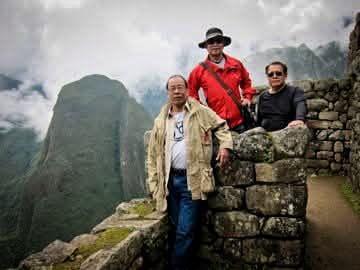Business
Pushing Climate Action through Passive Homes

In the stillness of the pandemic’s early days, oil industry civil engineer Norman Garcia ’95 finally sat down to watch An Inconvenient Truth, the 2006 documentary featuring former U.S. Vice President Al Gore. Surrounded by daily news of uncertainty and a dying planet, the film struck a more resounding chord. By the time the credits rolled, Garcia was in tears.
“I literally cried,” he said. “I had profited from the very industry driving climate change.”
Driven by guilt, Garcia set out to fight climate change with something close to home: houses designed to stay cool in the sweltering Philippine heat while using as little electricity as possible.
“This isn’t about slapping on solar panels,” Garcia said. “It’s about rethinking design from the foundation up.”
PassivHaus Philippines
After retraining in Canada as a building energy modeller and airtightness consultant, Garcia is now pushing for fossil fuel-free building practices.
By 2023, he had reached out to fellow Upsilonians Justinn Valerio ’95, a civil engineer and the Illustrious Fellow in Los Baños in 1998; architect Mikko Yap; ‘95, Migs Sagcal, a lawyer and the Illustrious Fellow in Diliman in 2004; and environmental planner Cassy Catapang ’70.
Later, architect Anton Villacorta ’95 and energy auditor Sigma Deltan Theresa Acedillo-Lapuz ’90 joined the group.
Together, they form the core of PassivHaus Philippines – a team that envisions a country where every Filipino lives and works in healthy, resilient, and low-energy homes and buildings by 2050.
“The group invites fellow Upsilonians and the wider public to support PassivHaus Philippines’s advocacy efforts, attend upcoming education events, and rethink how they design and build,” Garcia said.
“Because the truth is clear: our buildings are failing – climate-wise, cost-wise, and resilience-wise. These brods are stepping up at the right time,” he added.
What is a Passive House?
According to civil engineer Garcia, the Passive House Standard was pioneered in Germany over 30 years ago and has been proven worldwide to reduce heating and cooling energy use by up to 90 percent.
“Its approach is deceptively simple: airtight, super-insulated, well-shaded, and naturally ventilated buildings that keep indoor conditions stable even in extreme weather,” Garcia said.
“Globally, thousands of Passive Houses stand as proof. But in the Philippines, where only a handful of certified professionals exist, PassivHaus Philippines is the first organized, volunteer-led, Upsilonian-driven effort to tropicalize the model for national adoption,” he added.
At a recent webinar put together by the PassiveHouse team, Shih-Chieh Yeh, lead architect at BWK Green Architecture of Taiwan, presented the design of Thailand’s prototype Passive House in Bangkok – a modest two-storey family home built in 2019 that proved that world-class efficiency can be achieved even in the sticky heat of Southeast Asia.
“All of our design strategies are built around one simple idea: keeping heat out, and keeping the inside cool,” Yeh said.
Unlike traditional designs, the Bangkok Passive House utilized thick layers of insulation not only on the roof but also on the walls and even under the floor slab — a crucial feature in a city where ground temperatures can reach 29 °C.
High-performance double glazing keeps indoor glass surfaces from radiating heat, while careful shading and orientation help block the tropical sun. A compact ventilation unit with built-in cooling keeps fresh, dehumidified air flowing.
The result is a house that consumes so little energy that its entire cooling demand can be met with a modest 3.5-kilowatt system—less than what many Filipino households already use for a couple of air-conditioning units.
Beyond ‘green ratings’
Garcia said the Passive House Standard is also focused on providing comfort to families and workplaces, in addition to ensuring energy efficiency and performance. It ensures that even in heatwaves or storms, buildings remain livable without excessive energy consumption.
For the Philippines, where climate change is already testing the limits of infrastructure, Garcia said this is essential.
“Every brod who builds a home, a condo, or a business has a choice,” Garcia said. “Will they build for performance, or will they keep building the way we always have?”
Garcia said the conversation is about more than technology. It’s about public health and fairness.
“Our buildings are not built for the climate we live in,” Garcia said. “Families without air conditioning face impossible choices – do they spend on cooling, or put food on the table?”
He said that the Passive House approach offers a way forward: first reduce heat loads through smart design, then right-size efficient cooling systems, and finally add renewable energy.
“That’s the real climate action,” Garcia said.
Building momentum
With Garcia as executive director, the group of Upsilonians and a Sigma Deltan sister launched PassivHaus Philippines in 2025 after learning from pilot projects in Thailand, Sri Lanka, and Indonesia.
They now hold webinars and workshops that engage architects, engineers, train students, and spark conversations with green building allies such as the Philippine Energy Efficiency Alliance (PE2), the Green Architecture Advocacy Philippines (GreenAP), the Philippine Green Building Council (PHILGBC), the Philippine Green Building Initiative (PGBI), and the United Architects of the Philippines Makati Greenbelt Chapter (UAPMGBC).
Garcia said making the Passive House mainstream in the Philippines will require more than just enthusiastic designers. Suppliers need to bring in certified windows, insulation, and ventilation systems at affordable prices. Builders and contractors need training. And homeowners need to see and experience the comfort benefits firsthand.
“Once the learning curve flattens out, special concepts like Passive House should become the norm,” Garcia said.
PassivhausPH is already laying the groundwork with its Trailblazer Challenge, calling on early adopters to deliver the Philippines’ first certified Passive House. The organization promises lifetime membership, a decade of recognition as a Diamond sponsor, and permanent listing as a “Trailblazer” in its history.
Training events are also set to continue through 2026, including sessions on airtightness, ventilation, and tropical-specific cooling strategies. And Garcia encouraged Filipinos to connect with the global Passive House community at the International Passive House Conference in Essen, Germany in April 2026.
“The foundation has been laid,” Garcia said. “With partners across Germany, Austria, Taiwan — and with Filipino talent and industry — we can build Passive Houses here that are comfortable, affordable, and climate-ready.”


